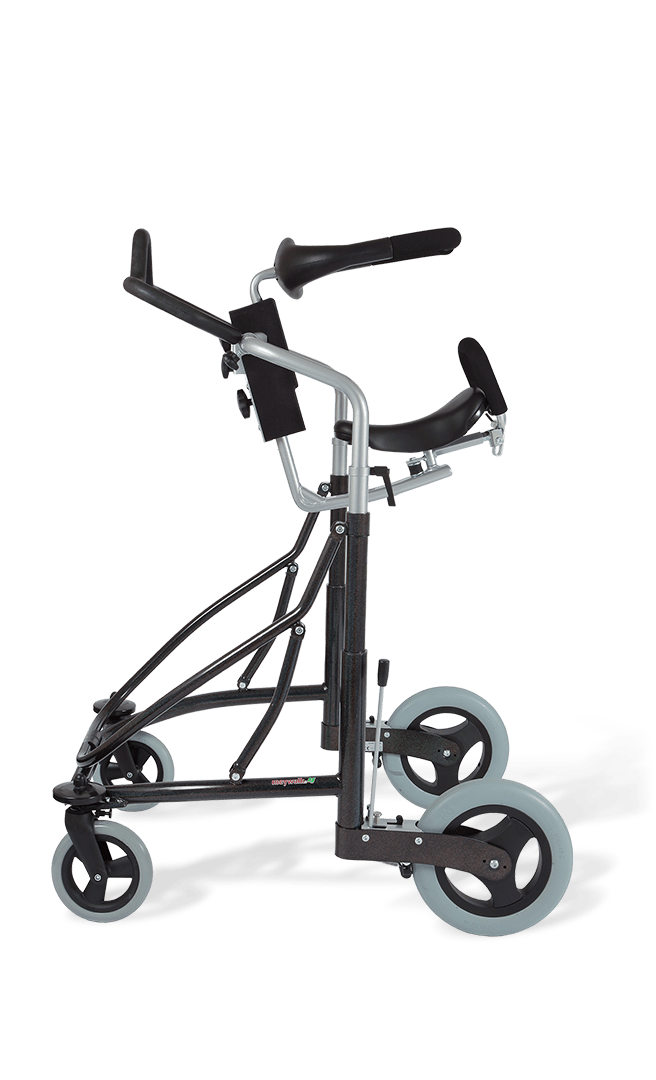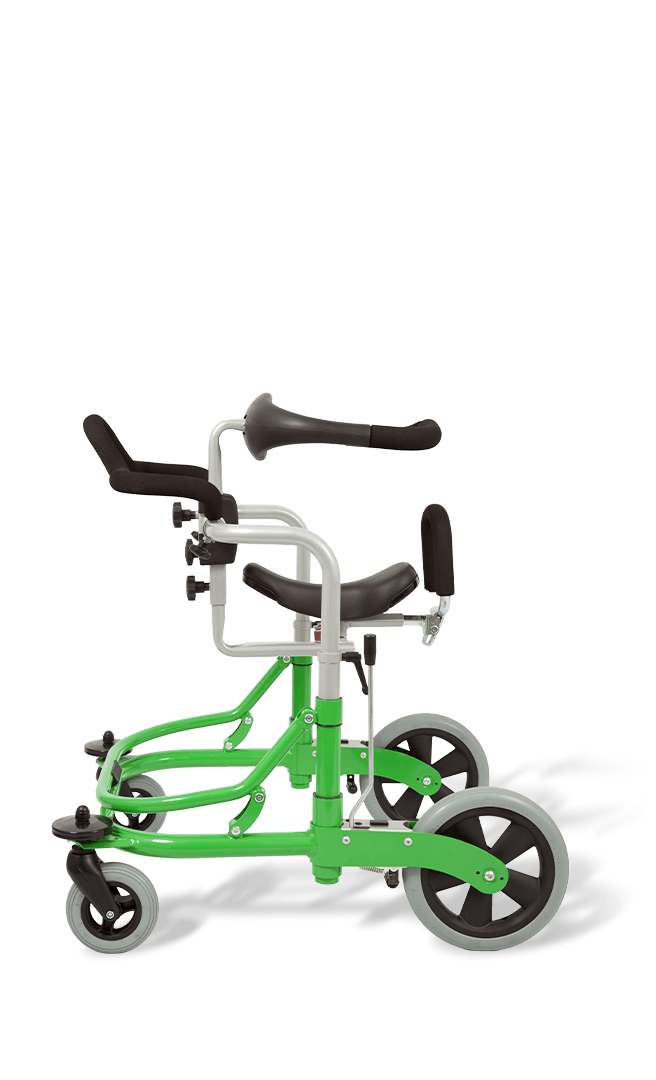Mille has relearned to walk – Rett syndrome
- 19. June 2023
- Reading time: 8 min.
Table of contents
Mille’s story
At 22 years old, Mille is an individual with typical Rett Syndrome. She resides in her own apartment within a community specifically designed to accommodate individuals with disabilities.
Mille was able to walk on her own until she was about 12 years old. Unfortunately, she lost her ability to walk on her own after that. Jannie, Mille’s mother, initially expressed concern:
It’s unfortunate that Mille can no longer walk, both for her quality of life and also for the impact it will have on our daily routines. She used to find so much joy in the simple act of walking.
However, it wasn’t long before Mille’s parents sprang into action. Taking a proactive approach, they decided Mille would undergo gait training. Each morning, they dedicated around 30 minutes to taking a stroll with Mille before she boarded the school bus. They repeated the ritual in the afternoon, accompanying Mille on another walk. They remained committed to this practice without fail, going the extra mile even when Mille’s father, Flemming, had to work late. He would make a point to return home in the afternoon to partake in this meaningful ritual.
To Mille’s parents, the idea of using a treadmill seemed unappealing, as it would merely feel like a clinical treatment devoid of the genuine joys associated with walking.
A treadmill would be boring; it would just be treatment.
Jannie and Flemming constantly supported Mille during her walks, which could be physically exhausting over time. Thus, their excitement was palpable when they discovered the Meywalk gait trainer, capable of assuming the arduous task on their behalf. With this newfound device, Mille could now engage in gait training without placing most of her body weight on her parents.
It brings us immense relief. Walking alongside her was challenging. As parents, it eases our burden. Furthermore, walking without a gait trainer could be perilous. If she were to stumble, we fear losing her.
About Rett Syndrome
Rett Syndrome is a rare neurodevelopmental disorder that predominantly impacts girls. It typically manifests between the ages of 6 and 18 months, although the onset can occur earlier or later than this range in some cases. The condition is characterised by the gradual loss of hand function, diminished speech abilities, and decreased social engagement. Additionally, individuals with Rett Syndrome often experience persistent impairments such as tonus disturbances, scoliosis, epilepsy, reduced bone mass, and imbalances in the autonomic nervous system. These imbalances can lead to breathing difficulties and constipation.
It’s important to note that the lasting impairments resulting from Rett Syndrome can vary significantly from person to person. Due to this variability, researchers strongly advocate for individualised intervention plans incorporating daily gait training. Such personalised approaches aim to address the specific needs and challenges each individual affected by Rett Syndrome faces.
Read more about Rett Syndrome on www.nhs.uk
Mille’s training
Philip, Mille’s dedicated physiotherapist, consistently considers her abilities and areas where she may need improvement. As a result, the primary objective of the intervention has been to preserve and re-establish Mille’s capacity to stand and walk.
Based on this, Philip developed a training plan that focuses on three things:
Muscular stretching
Continuous weight-bearing
Strengthening of the lower extremities
Each day, Mille engages in various training activities, including four 30-minute sessions with the specialised gait trainer. Additionally, she performs “sit-to-stand” exercises and incorporates stretching exercises into her regimen. Mille alternates between conducting her daily training sessions with both her parents and a dedicated caregiver at her place of residence. Her physiotherapist, Philip, actively participates in Mille’s training twice a week and tailors the programme to meet her current abilities and requirements.

Gait training and Rett Syndrome
The Danish Rett Syndrome Association states that Rett Syndrome (RTT) is predominantly attributed to a genetic mutation found on the X chromosome. This genetic alteration is responsible for the higher prevalence of the condition among girls compared to boys. RTT is a complex disorder, and individuals affected by it display a wide range of functional diversity.
While some individuals with RTT may never attain independent sitting or standing positions, it is noteworthy that a minority of children with the condition can achieve impressive physical capabilities. These abilities may include running, skiing, and even engaging in activities like jumping on a trampoline1. The spectrum of functional abilities observed among individuals with RTT highlights the significant variability associated with the disorder.
As part of a 2004 study conducted by the Australian Rett Syndrome Database (ARSD), 99 women and girls with Rett Syndrome between the ages of 1.5 and 28 were examined. The data revealed a significant range of abilities within the group. 43% of the participants exhibited independent walking functions, including side-stepping and 180-degree turning. Surprisingly, 14% of the individuals were even capable of running. On the other hand, 30% of the participants had no walking function at all2. This demonstrates both the varied nature of the disease and the potential for training and improvement.5
Considering such variability, Lotan and Hanks (2006) recommend a comprehensive interdisciplinary evaluation for each child in their guidelines for physiotherapeutic intervention for individuals with Rett Syndrome. This evaluation would serve as the basis for developing an individualised intervention programme4. The aim is to address the specific needs and capabilities of each individual affected by Rett Syndrome, allowing for targeted interventions and support.
Indeed, maintaining or improving physical function, preventing deformities, promoting mobility, and enhancing social inclusion are crucial objectives for an intervention programme designed for individuals with Rett Syndrome.
Lotan and Hanks outlined the five overarching objectives of physiotherapy for individuals with RTT:
- Maintain or improve physical function
- Develop or maintain mobility
- Prevent or reduce deformities
- Alleviate discomfort and irritation
- Enhance independence
By targeting these objectives, a comprehensive physiotherapy programme can play a vital role in optimising the physical, functional and social outcomes for individuals with Rhett Syndrome. Through adequate and impactful training, certain individuals can restore their walking ability, even after 15 to 20 years of relying on wheelchairs4.

How a VELA Meywalk gait trainer makes a difference
The Rett Syndrome Clinic at Rigshospitalet3 advises the following:
individuals who are non-ambulatory should stand for a minimum of 30 minutes per day, and individuals who can walk and stand with or without support should do so for a minimum of two hours daily.
This recommendation is based on the numerous benefits that movement and upright posture provide, including improved circulation, enhanced bone density, better bowel function, and a reduced risk of developing scoliosis1.
Moreover, utilising a gait trainer for adults not only aids users in achieving independent mobility but also empowers them to seek out and engage in social interactions. This aspect of the device plays a crucial role in stimulating the user’s mental well-being.



